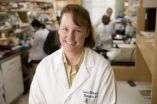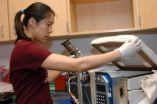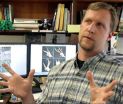(Press-News.org) LOS ANGELES (July 5, 2011) – Researchers at The Saban Research Institute of Children's Hospital Los Angeles have successfully created a tissue-engineered small intestine in mice that replicates the intestinal structures of natural intestine—a necessary first step toward someday applying this regenerative medicine technique to humans.
The study led by Tracy C. Grikscheit, MD —"A Multicellular Approach Forms a Significant Amount of Tissue-Engineered Small Intestine in the Mouse"— has been published in the July issue of Tissue Engineering Part A, a premier biomedical journal.
"In this paper, we are able to report that we can grow tissue-engineered intestine in a mouse model, which opens the doors of basic biology to understand how to grow this tissue better," said Dr. Grikscheit, who is also an assistant professor of surgery at the Keck School of Medicine of the University of Southern California.
As a pediatric surgeon, Dr. Grikscheit is concerned with finding solutions for some of her more vulnerable patients—newborns. Infants born prematurely are at increased risk for a gastrointestinal disease called necrotizing enterocolitis (NEC), which occurs when the intestine is injured. The cause is unknown.
Early treatment of NEC is essential to stop the potentially life-threatening leakage of bacteria into the abdomen. Often, the only solution is surgical removal of the small intestine. However, this option leaves the baby dependent on intravenous feeding and at risk for liver damage from subsequent intravenous nutrition. Organ transplants are possible but not a long-term solution, with only a 50 percent chance the grafted intestine will last past the child's 5th birthday.
Dr. Grikscheit, a member of The Saban Research Institute's Developmental Biology and Regenerative Medicine program, envisions a better solution. "The small intestine is an exquisitely regenerative organ. The cells are constantly being lost and replaced over the course of our entire lives," she explained. "Why not harness that regenerative capacity to benefit these children?"
Working in the laboratory, the research team took samples of intestinal tissue from mice. This tissue was comprised of the layers of the various cells that make up the intestine — including muscle cells and the cells that line the inside, known as epithelial cells. The investigators then transplanted that mixture of cells within the abdomen on biodegradable polymers or "scaffolding."
What the team wanted to happen did — new, engineered small intestines grew and had all of the cell types found in native intestine. Because the transplanted cells had carried a green label, the scientists could identify which cells had been provided — and all of the major components of the tissue-engineered intestine derived from the implanted cells. Critically, the new organs contained the most essential components of the originals.
"What is novel about this research is that this tissue-engineered intestine contains every important cell type needed for functional intestine. For children with intestinal failure, we are always looking for long-term, durable solutions that will not require the administration of toxic drugs to ensure engraftment. This tissue-engineered intestine, which has all of the critical components of the mature intestine, represents a truly exciting albeit preliminary step in the right direction," said Henri Ford, MD, Vice President and Surgeon-in-Chief at Children's Hospital Los Angeles.
"We demonstrated that we are providing all of the important cells—the muscle, nerve, epithelium, and some of the blood vessels," noted Frédéric Sala, PhD, lead author. "All of these are critical to proper functioning of the tissue, and now we know their origins." Next up are additional tissue-growing experiments—each one of which may bring that much closer the prospects of clinical testing and a solution for babies in need.
INFORMATION:
About Children's Hospital Los Angeles
Children's Hospital Los Angeles has been named the best children's hospital in California and among the best in the nation for clinical excellence with its selection to the prestigious US News & World Report Honor Roll. Children's Hospital is home to The Saban Research Institute, one of the largest and most productive pediatric research facilities in the United States and is one of America's premier teaching hospitals, affiliated with the Keck School of Medicine of the University of Southern California since 1932.
For more information, visit www.CHLA.org. Follow us on Twitter, Facebook, YouTube and LinkedIn, or visit our blog: www.WeAreCHLA.org.
Researchers engineer functioning small intestine in laboratory experiments
The ability to create a new organ may someday lead to answers for babies with a life-threatening gastrointestinal condition
2011-07-07
ELSE PRESS RELEASES FROM THIS DATE:
Final space shuttle to carry 5 CU-Boulder-built payloads
2011-07-07
The University of Colorado Boulder is involved with five different space science payloads ranging from antibody tests that may lead to new bone-loss treatments to an experiment to improve vaccine effectiveness for combating salmonella when Atlantis thunders skyward July 8 on the last of NASA's 135 space shuttle missions.
One experiment, sponsored by the global pharmaceutical companies Amgen and UCB, will test an antibody to sclerostin -- a protein that has a negative effect on bone formation, mass and strength -- on lab mice flying on the shuttle. Researchers on the project ...
Eggs may help prevent heart disease and cancer
2011-07-07
One of nature's most perfect foods may be even better for us than previously thought.
While eggs are well known to be an excellent source of proteins, lipids, vitamins and minerals, researchers at the University of Alberta recently discovered they also contain antioxidant properties, which helps in the prevention of cardiovascular disease and cancer.
Jianping Wu, Andreas Schieber and graduate students Chamila Nimalaratne and Daise Lopes-Lutz of the U of A Department of Agricultural Food and Nutritional Science examined egg yolks produced by hens fed typical diets of ...
Self-paced walking test useful for evaluating progress in lifestyle intervention programs
2011-07-07
HOUSTON- (July 5, 2011) - The self-paced walking test, known as the 400-meter walk test, is effective in measuring improved physical function in postmenopausal women who have lost weight through healthy physical activity and dietary changes, according to collaborative research conducted by The University of Texas Health Science Center at Houston (UTHealth) and The University of Pittsburgh.
"The 400-meter self-paced walk test is a simple, cost-efficient and effective test clinicians or researchers can use to evaluate progress in a weight loss or physical activity program," ...
Being small has its advantages, if you are a leaf
2011-07-07
The size of leaves can vary by a factor of 1,000 across plant species, but until now, the reason why has remained a mystery. A new study by an international team of scientists led by UCLA life scientists goes a long way toward solving it.
In research federally funded by the National Science Foundation, the biologists found that smaller leaves are structurally and physiologically better adapted to dry soil because of their distinct vein systems.
The research will be published in an upcoming print issue of the journal Plant Physiology and is currently available in ...
USC researchers link genetic marker to rectal cancer treatment
2011-07-07
A team of researchers led by Keck School of Medicine of the University of Southern California (USC) oncologist Heinz-Josef Lenz, M.D., has identified a genetic marker that may predict which patients with rectal cancer can be cured by certain chemotherapies when combined with surgery. The discovery, scheduled for publication in the August 1 edition of Clinical Cancer Research, brings doctors closer to customizing cancer treatment to individual patients.
Lenz, professor of medicine and preventive medicine in the division of medical oncology at the Keck School and the study's ...
Old life capable of revealing new tricks after all
2011-07-07
Archaea are among the oldest known life-forms, but they are not well understood. It was only in the 1970s that these single-celled microorganisms were designated as a domain of life distinct from bacteria and multicellular organisms called eukaryotes.
Robert Gunsalus, a UCLA professor of microbiology, immunology and molecular genetics, developed an interest in Archaea because of their ability to thrive in harsh environments. Now, using state-of-the-art imaging equipment at the California NanoSystems Institute (CNSI) at UCLA, he has shown for the first time that a type ...
Ruminant headgear: A mystery awaiting unraveling
2011-07-07
EUGENE, Ore. -- Emerging from the heads of most cud-chewing mammals, headgear inspire an almost mystical and certainly majestic aura. But, scientists say, we know shockingly little about them.
In a paper appearing online ahead of regular publication in the Proceedings of the Royal Society B, a London-based international journal dedicated to biology, a three-member scientific team spells out what is known -- and not known -- about antlers, horns, pronghorns and ossicones.
For antlers, think deer, moose and elk. Horns are worn by cattle, sheep and goats; ossicones by ...
Gene therapy stimulates protein that blocks immune attack and prevents Type 1 diabetes in mice
2011-07-07
Increasing a specific protein in areas of the pancreas that produce insulin blocks the immune attack that causes type 1 diabetes, researchers reported in the August issue of the Journal of Clinical Investigation, published early online.
The discovery could lead to a drug that prevents the progression of type 1 diabetes in people newly diagnosed who are in the "honeymoon" phase of the disease, when the immune system has not yet destroyed all of the insulin-producing beta cells in the pancreas.
The finding could also lead to new drugs for overcoming organ rejection in ...
Childhood asthma linked to depression during pregnancy
2011-07-07
July 5, 2011– Anxiety, stress and depression during pregnancy may lead to a greater risk of asthma for your child, according to researchers at Columbia University's Mailman School of Public Health. Study results are published in the July issue of Annals of Allergy, Asthma & Immunology, the scientific journal of the American College of Allergy, Asthma and Immunology (ACAAI).
"Approximately 70% of mothers who said they experienced high levels of anxiety or depression while they were pregnant reported their child had wheezed before age 5," said Marilyn Reyes, senior research ...
Just add water and treat brain cancer
2011-07-07
Researchers at the Johns Hopkins University School of Medicine have developed a technique that delivers gene therapy into human brain cancer cells using nanoparticles that can be freeze-dried and stored for up to three months prior to use. The shelf-stable particles may obviate the need for virus-mediated gene therapy, which has been associated with safety concerns. The report appears in the August issue of Biomaterials.
"Most nonviral gene therapy methods have very low efficacy," says Jordan Green, Ph.D., an assistant professor of biomedical engineering at Johns Hopkins. ...
LAST 30 PRESS RELEASES:
Bacteria resisting viral infection can still sink carbon to ocean floor
Younger biological age may increase depression risk in older women during COVID-19
Bharat Innovates 2026 National Basecamp Showcases India’s Most Promising Deep-Tech Ventures
Here’s what determines whether your income level rises or falls
SCIE indexation achievement: Celebrate with Space: Science & Technology
Children’s Hospital Colorado performs region’s first pediatric heart and liver dual organ transplant
Australian team discover why quantum computers have memory problems over time
What determines the fate of a T cell?
Candida auris: genetic process revealed which could be treatment target for deadly fungal disease
Groundbreaking discovery turns household plastic recycling into anti-cancer medication
Blocking a key inflammatory pathway improves liver structure and vascular function in cirrhosis, study finds
Continuous spread: Raccoon roundworm detected in nine European countries
HKUST Engineering researchers developed a novel photodetector to enhance the performance of on-chip light monitoring
Strategic river sensors could have forewarned of Texas Camp flood disaster
Drone sampling of whale breath reveals first evidence of potentially deadly virus in Arctic
Roman soldiers defending Hadrian’s Wall infected by parasites, study finds
Pinochet’s prisoners were tormented with music but still found solace in it, a new book reveals
Fertility remains high in rural Tanzania despite access to family planning
AI-assisted device can improve autism care access
Kinetic careers
Uncovering how parasitic plants avoid attacking themselves to improve crop resistance
Nanoparticle vaccine strategy could protect against Ebola and other deadly filoviruses
Study finds brain care score can predict risk of stroke across racial groups
Key lung immune cells can intensify allergic reactions
Do hormones explain why women experience more gut pain?
New materials conduct ions in solids as easily as in liquids
Breakthrough of the Year: Renewable energy begins to eclipse fossil fuel-based sources
LLM use is reshaping scientific enterprise by increasing output, reducing quality and more
Introducing LightGen, a chip for ultra-fast, ultra-efficient generative AI
Astronomers see fireworks from violent collisions around nearby star
[Press-News.org] Researchers engineer functioning small intestine in laboratory experimentsThe ability to create a new organ may someday lead to answers for babies with a life-threatening gastrointestinal condition


